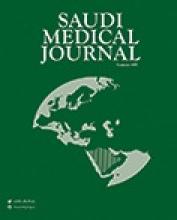Abstract
OBJECTIVE: To explore the role of and report on congenital and genetic cerebrovascular anomalies as risk factors for stroke in a prospective and retrospective cohort of Saudi children.
METHODS: Children with stroke were evaluated at the Division of Pediatric Neurology (DPN), or were seen as inpatients in the Pediatric Wards at King Khalid University Hospital (KKUH), Riyadh, Kingdom of Saudi Arabia during the periods July 1992 to February 2001 (retrospective study) and February 2001 to March 2003 (prospective study). Stroke work-up for each suspected case included hemostatic assays, serological, biochemical and neurophysiological tests. Neuroimaging modalities included routine skull x-rays, CT, MRI, magnetic resonance angiography (MRA) and conventional cerebral angiography.
RESULTS: Of 104 children with stroke, congenital and genetic cerebrovascular anomalies were the underlying risk factor in 7 (6.7%). The patients were evaluated at the DPN at a mean age of 66 months (range = 8 months to 11 years, median = 6 years); and they had stroke at a mean age of 48 months (range = 2 months to 10 years, median = 8 months). Four patients had stroke in association with neurocutaneous syndromes. Two had Sturge-Weber syndrome (SWS), one had Klippel-Trenaunay syndrome associated with SWS, and the fourth had neurofibromatosis type 1. Two patients had intracranial hemorrhage secondary to ruptured aneurysm. A girl (aged 9 years and 4 months) had left posterior cerebral artery aneurysm. She was diagnosed to have autosomal dominant polycystic kidney disease following renal ultrasonography. She died 5 months later despite surgical intervention (clipping of aneurysm). The second child was an 8-month-old boy who presented with subarachnoid and intraventricular hemorrhage (IVH) following ruptured anterior communicating artery aneurysm. He recovered with no residual symptoms following successful clipping of the aneurysm. Arteriovenous malformation (AVM) caused IVH in a 7-year-old boy who reported to hospital 5 hours after onset of headache, vomiting, drowsiness, and dizziness. Following drainage of the IVH and stabilization of the patient, the AVM was successfully embolized 6 weeks later.
CONCLUSION: As a group, congenital and genetic cerebrovascular anomalies constitute a significant risk factor for stroke in Saudi children. Recognition of these diseases is important since some are treatable and because other family members may be at risk.
- Copyright: © Saudi Medical Journal
This is an open-access article distributed under the terms of the Creative Commons Attribution-Noncommercial License (CC BY-NC), which permits unrestricted use, distribution, and reproduction in any medium, provided the original work is properly cited.






